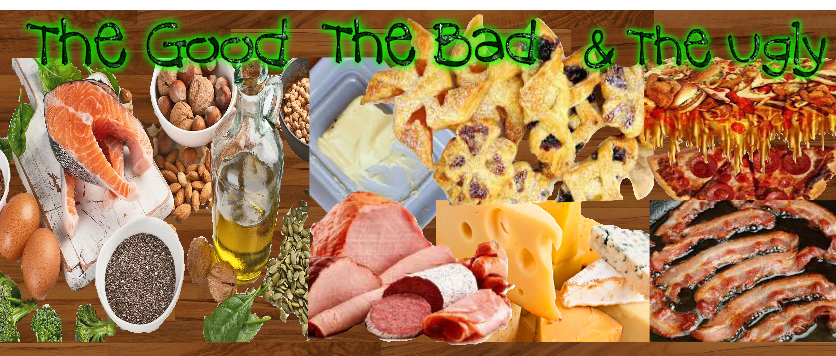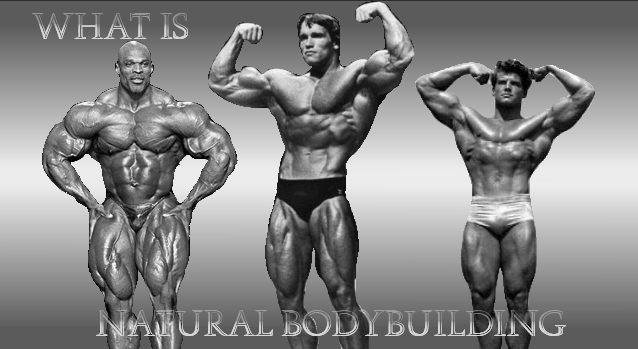Maximum Metabolism
Maximum metabolism: if weight loss or fitness is your goal this year then this article is the one for you.
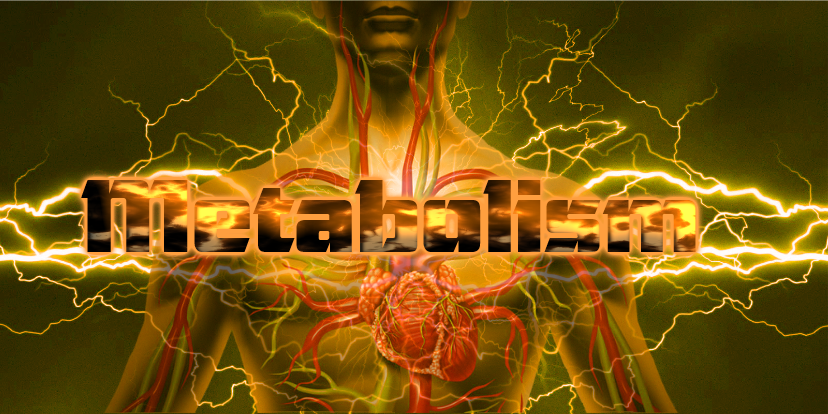
Metabolism is a little like saying: (Over training or Fat) in society today, their often taken out of context even blamed or used as scape-goats if results of poor exercise or weight loss progress does not show itself quickly.
The truth is: The Metabolism is not a simple process, it varies, there is no one size fits all.
Metabolism is about energy expenditure: enzymes that break-down food into ATP, (Adenosine Triphosphate) which in turn provides energy at a cellular level; while tracking and dispersing nourishment to where its needed, keeping the internal organs, brain, lean muscle and bone mass etc., nourished.
Maximizing metabolism speed is possible; but these levels are usually only altered in small increments.
The central nervous system holds a tight cap on this, dividing energy usage into three broad categories: BMR basil metabolic rate (at complete bed rest), RMR, keeping basic functions working with (little energy expenditure), TEF (thermic effect of food) keeping the body warm, as well as energy expended on physical activity (work, exercise etc.).
So, What The Heck Is a Metabolism Anyway?
A metabolism is a series of chemical processes that occur within all living things at a cellular level to maintain life. Where humans are concerned the metabolism is important in food/energy processing; effecting weight gain or loss as well as maintaining body heat and vital body functions.
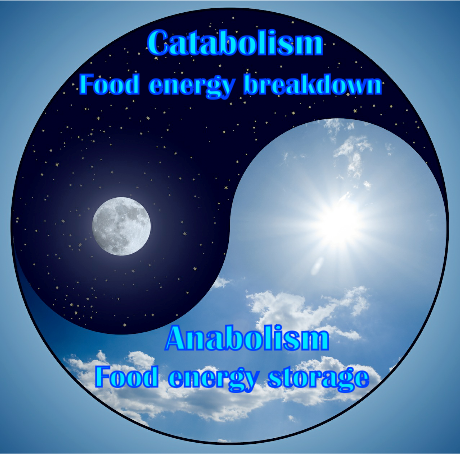
There are 2 distinct phases of the maximum metabolism process. The line and relationship between Anabolism and Catabolism is microscopically fine, both forms of operations within cells, act a little like yin and yang to one and other.
Both processes need each other to form a healthy metabolism, anabolism is actually energized by catabolism, this is a symbiont relationship of-one needing the other.
Anabolism or anabolic (as you may know), refers to growth or strength production in cell size often relating to increases in muscle, bone mass, hair growth, even sex drive.
Anabolism: uses different enzymes from catalysis, using ATP (adenosine triphosphate) this anabolic process where metabolism is concerned, begins the further breakdown of ATP (the body’s raw source of energy from food).
As this cellular enzyme activity breaks down food further it will be stored for future use as glycogen. ATP is typically stored in muscle where short intense bursts of energy are needed, such as: (sprinting, weight training, shot-put or powerlifting etc.).

Further refinement also stores food energy as glycogen, these stores are
typically found in the liver and muscle cells, this energy is often used in longer
lasting activity, such as: (aerobics, jogging, walking, cycling etc.).
Anabolisms' metabolic pathways are commonly ignited through signals produced by 'anabolic hormones'.
Depending on which level of complexity the metabolism is in; largely depends on which hormones and at what stage their being used at: (growth hormone, testosterone, ‘estrogen in women’ or insulin), to mention only a few; are common ones related to this process.
Catabolism: as anabolism is often seen as constructive in the metabolism; then catabolism would be the destructive, catabolic is more often referred to as the metabolic breakdown of muscle and adipose (fat) tissue.
Stimulation of catabolism is more effective when leaner foods and smaller portions are adhered to: other catabolic effects like aerobic exercise, also breaks down living tissue for energy.
This all-consuming process of catabolism needs anabolism to keep this process from eating itself out of existence.
Catabolism is often ignited by hormone signals such as: (adrenaline, glucagon and cortisol) to name a few; all play a part and depends on what stage of complexity metabolic enzyme break down is in.
Note: to over simplify these two, I often look at anabolism as similar to anaerobic training: more associated to using energy stores (slower), as in resistance training producing increases in strength, muscle and bone mass.
Catabolism is similar in nature to (aerobic exercise), using a more catabolic or faster approach to consuming or (burning energy/calories).
Anabolism produces and stores energy: catabolism is the break down of stored energy, even living tissue if it needs it.
What Types of Things Effect or Increase Metabolic Speed?
As we age from 20 years on, we can commonly see a decrease in (BMR) levels of 1-2% per decade as lean body mass is reduced through age, metabolism slows as a result, affecting the body's production of heat or thermogenesis.
Previously consumed food or liquids takes a lot of effort to digest and disperse nutrition everyday, this effort of enzyme breakdown affects metabolism speed, (often leaving us feeling tired or sluggish after meal time).
The common cold and other illnesses can also affect metabolism speed: having to slow as more life-threatening actions are taking place to insure the bodies survival takes precedence.
Environment temperature can also affect BMR levels; folks living in warmer climates are often seen to have slightly faster metabolic levels than others that live with longer periods of winter, (typically storing more body fat for thermic reasons) this adjustment in metabolism is a survival strategy of the body.
Last but certainly not least affecting metabolism is stress: stress in all of its forms can greatly affect metabolism production and the bodies BMR, over time. Positive or negative stress can be mental or physical but their usually deeply related.
Positive stress can serve by: being sexually active with a partner, sex burns calories while producing excitement and contentment. Other positive stress is resistance training, this stimulates active and connective muscle tissue increasing Catabolic energy expenditure.
Aerobic activity also increases positive stress on the body by increasing BMR levels. Negative stress can come from illness, worry, anxiety, poor eating habits, drug or alcohol consumption including social unrest between your partner, friends or family.
The daily processes of the metabolism and measuring it are complicated as were all different, there is no such thing as a one size fits all.
Age,
height, weight, gender as well as Meso, Ecto and Endomorph (body types), including climate and stress levels all play a part even if its small, in everyone’s BMR
calculations.
For fun, Your Welcome to try the BMR Calculator from the privacy of your own device; if your unsure of how to use it, just below gives a full explanation of it's use.
BMR and Daily Calorie Expenditure Powered by DWT
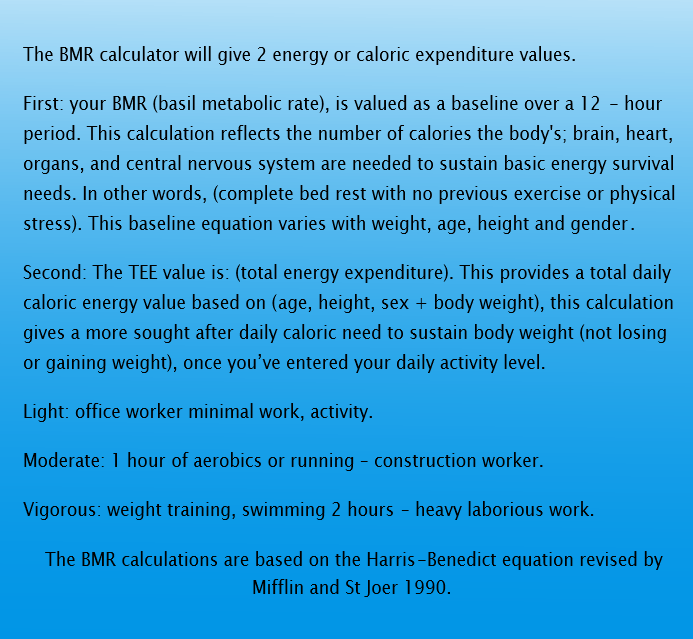
So lets look at what is meant by RMR:
or Resting Metabolic Rate; is calculated at a state of rest, the difference is: your conscious and awake but not physically active at a job, house work or exercising.
Metabolic levels like, energy production for the internal organs, brain, and lean muscle mass increase energy production levels greater than when we sleep.
RMR calculations differ from person-to-person, often measured by body mass or surface area, e.g. a tall person and short person (that weigh the same), will often vary in RMR rates.
The taller person will/may have higher RMR levels because of a larger surface area, which includes more lean muscle tissue and a larger surface area for the body to heat.
Note: when using BMR/RMR calculations the RMR calculation is the one to observe as these values tell us what we need to achieve to maintain health at a minim level, meaning: just enough calories for basic survival needs during a wakened state.
Note: with all RMR calculations extra curricular activity, sports, work, walking exercising is all beyond these calculations, meaning:any and everything you do or preform will produce a greater caloric deficit (weight loss).
So the all important TEE value in the above calculator provides this equation for your activity level.
Is Weight Loss Related to Metabolism?
A Slow metabolism is commonly blamed in weight loss efforts. Weight loss or (dieting), is often a goal worked on through stricter eating habits basing the entire process on speed or fast results... is commonly the individual goal, but: not the goal of the metabolism.
The old saying: (you can’t outrun a poor diet), is accurate; the metabolism does control ‘weight’, but it’s like a computer: its only as good as the information that’s fed into it.
In other
words: what’s on the end of your fork will more than likely determine
metabolic efficiency and weight loss results.
This
process works on its own time not ours, its agenda is simple: to survive at all
costs, by processing and regulating food-energy, ultimately keeping us alive and healthy while stimulating mood and contentment levels.
So is weight loss or weight gain related to metabolism… yes
Your maximum metabolism speed can be manipulated or increased in (small increments). Even though small in nature; over time, this can produce amazing results. Speeding this process safely is controlled through healthier eating and drinking habits.
Unhealthy fats or heavily sugared foods are denser in calorie values. Fat holds twice the calories as simple carbs, refined sugars also hold lots calories, but with little food or nutritional value, that often come with an energy crash and insulin spike.
This can easily become the ultimate evil predator for the body’s metabolism, as it struggles with trying to process heavy or empty calories.
E.g. trans fats, gluten in wheat, breads etc., highly refined foods and sugars, including the junk food isles of convenient stores as well as diner-style/fast and fried food outlets.
As you can see; a
healthy diet is the super-seeding factor in increasing metabolic speed.
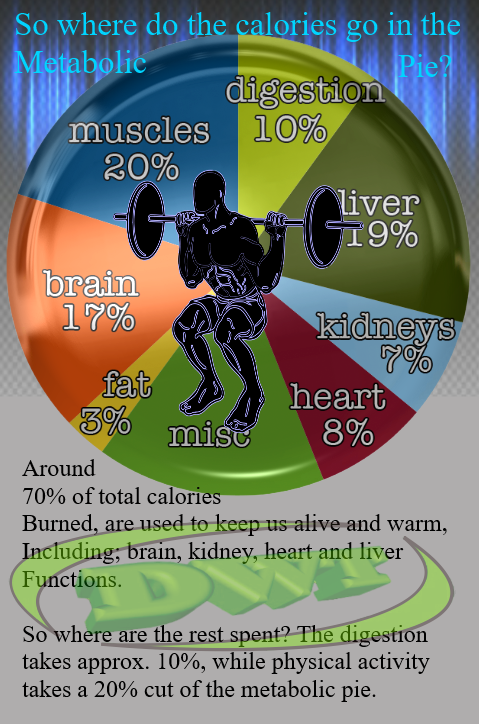
If you look at the pie chart provided, lean muscle tissue is responsible for 20% of total energy needs.
Muscle tissue is a gluttonous beast in calorie consumption taking a healthy slice of the metabolic pie.
Fruits and vegetables as-well-as the vitamins and minerals they provide helps assist metabolism speed.
Increasing maximum metabolism speed isn't about eating salads to reduce calories: vegetables, salad or fruit increase weight loss efficiency because...
Vegetables are processed and utilized quicker than protein or healthy fats, while the fiber they provide acts as a broom for the colon.
A clean efficient working colon will always increase maximum metabolism production, ultimately producing safe healthy weight loss results.
10 Secrets to Maximum Metabolism Efficiency
So... lets see where some small naturally safe to use secrets might lie to optimize maximum metabolism efficiency, things that can activate and stimulate a healthy metabolism.
# 1 Exercise/activity:
Sports, Cardio, weight training, walking, jogging, calisthenics, sit-up and push-ups etc., anything that stimulates thermic activity (burning calories). If you work at a desk: stand and stretch every so often, have a sip of cold water as often as you can, (just don’t get fired)!
# 2 Weight loss:
If you can motivate yourself enough in the morning - a healthy, short dose of cardio 12-15 mins. will increase you're maximum metabolism levels before breakfast, this revs'-up metabolic and thermic production, scorching off yesterdays unused calorie levels.
#3 Start Breakfast Early:
Include lean sources of protein and complex carbs, increasing times between meals gives a longer metabolic time-span between feedings. If you work in an office; (consider portion size, keeping carbs lower on the menu). If your job is physical; (consider more complex carbs, and protein).
# 4 Stay Hydrated:
Often hydration is overlooked in the metabolic/diet efficiency equation. 250-300 ml. refrigerated water first thing before coffee - is a game changer to charging early morning metabolic reaction time.
# 5 A Cup Of Coffee:
Enjoy a cup or 2 of coffee in the morning and later afternoon, (keeping additives, creams and refined sugars minimized), coffee is also a great metabolic and digestive enzyme activator. Coffee is a natural workout and energy booster as well as a powerful antioxidant.
# 6 Vitamin B-Complex:
A B-complex vitamin is also known to be a strong metabolic aid in increasing you're maximum metabolism and digestion, avoid excessive use: often 50 mg. is enough. For an active healthy adult male:100 mg., may be more suitable.
# 7 Alternate Fitness Cycles:
And intensity: 1 week of cardio training, followed by a week of weight/strength training, alternate until physic, weight loss, fitness or well being goal is achieved. Everyone wants a training routine... routines often yield poor results, changing training cycles produces them!
# 8 Don't Skip Breakfast:
A large heavy breakfast often slows metabolic reaction time to much: consider whole grain cereals, oatmeal with low fat or substitute milk as an option. Also consider fruit or a protein smoothie, pureeing some foods, eases metabolic and digestive tension; ultimately increasing maximum metabolism efficiency and weight loss results.
# 9 Protein Rich Foods:
Let protein rich foods take up more of your plate, such as: (Eggs, nuts, legumes, beans, seeds, fish and poultry ‘skin removed’), keep fruit or salad servings small/on the side with no dressing. Yes, I know it sucks: but (fattening, sweet dressings, sauces and higher levels of sodium) are the enemy of increasing metabolic stamina.
Which Brings us to # 10 Low Salt Soup:
Consider making low salt soups for some lunch and evening
meals, the body has an easier time breaking down cooked foods with vegetables,
chicken, meat etc., than heavy glutenous sandwiches or pasta. Purchased canned soups
with high sodium or gravy/(broth) content, should be avoided.
Note: the heart and other organs burn a set number of calories typically, but cleaner eating habits and regular exercise can increase you're maximum metabolism by a calorie deficit of 500 - 700 extra calories per day. Please, try to use good judgement on foods that don’t agree with you that may cause allergies or that may-be reactive if ingested.
Excess sodium can be a destroyer of metabolism speed!

All to often I'm asked: how should a good diet work, I mean; is it the metabolism that's important, or is it Macro-nutrients, physical exercise or is it the timing and size of my meals?
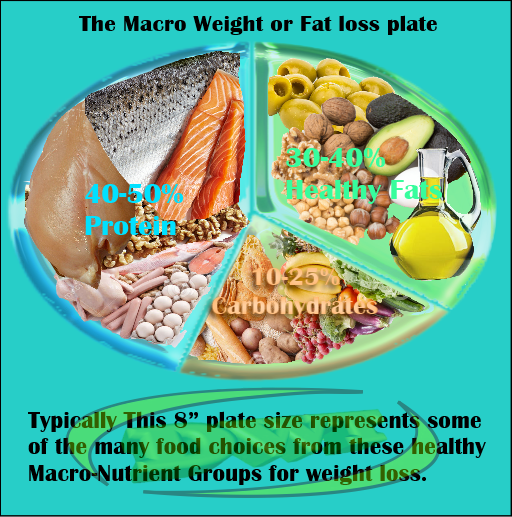
Metabolism and weight loss:
Actually it's all of them, So... lets focus the microscope a little closer on Macro nutrients, Metabolism, Muscle and exercise:
The plate illustrations and there serving sizes as well as their macro values are close in their accuracy depending on what your goal is.
Ultimately how we load macro-quantity to our plates, including plate size - all makes a difference in metabolic energy expenditure and goal related results.
So, where weight loss is a concern: higher healthier portions of protein and fats are preferable to higher levels of carbs or salads. as Illustrated.
Carbohydrates are our main source of fuel, the metabolism breaks carbs down easier than fats or protein-but, excessive amounts are stored as (adipose), where as other healthy macros aren't - carbs taste good so we crave them, but what we don't use likes to stick!
Healthy fats alleviate this by providing sustained energy and healthy dieting contentment.
Feeding the metabolism Complex carbs is the fuel needed for metabolic breakdown sustaining longer energy stores ensuring contraction intensity levels during workout duration.
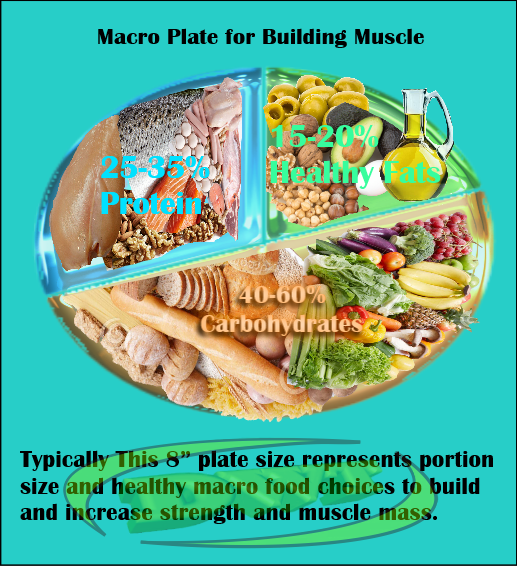
Building Muscle:
Almost nowhere is it more important to understanding the metabolism than it is in weight training/bodybuilding; short burst-intense training, burns a lot of calories over time.
Knowing your macros; the right quantity and plate size with 30% protein 40-60% healthy carbs., and lower healthy fats are the metabolisms best friend in achieving muscle and strength training goals.
The type quantity and quality of Macro's you chose: determines metabolic speed - Speed = faster results and a healthy efficient metabolism!
Experiment with the food types and ratios, while trying to avoid adding things to your food such as: gravy, ketchup, salt, salad dressings etc., if weight loss is a concern.
As you probably know yourself; we can commonly witness people that set and even accomplish their fitness or weight loss goals; only to see most fail at the end... By gaining all the weight back, and in most instances gaining even more back, so what gives?
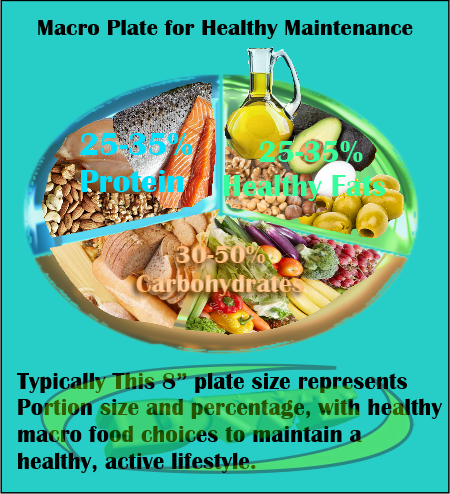
Healthy Maintenance:
Understanding how metabolic efficiency breaks down food and how to set and achieve goals; takes persistence, patience and a train-load of discipline for most!
The most common thing that often gets missed in eating/weight loss, and exercise goal setting is: The simple fact of setting a maintenance goal with continued healthy eating and portion habits.
The metabolism as mentioned: is only as good as what it's fed! Enter the maintenance Diet - it's (importance) not can - but will, reflect post goal maintenance longevity.
If your close to or have recently achieved a weight loss, physic or fitness goal, keep all your hard-won effort working for you, by setting a new goal... maintaining a healthy, active metabolism: will build new discipline into you keeping your goal as healthy as your metabolism.
Maximum metabolism summery:
A healthy Metabolism is ultimately created and maintained by one person: you! Taking pills, or metabolic boosters isn’t necessary unless you have a special or medical condition.
If general weight loss, increasing muscle and strength, tone or a stronger sense of physical well-being is what your after; the top ten metabolic natural optimizer's I’ve listed above, are great places to aim for.
Try to apply your own intuition and good common sense to any changes you may want to make this new year to build that better body your after; by applying new changes slowly!
If your new to fitness, macro-nutrient and diet assessment, always consult a professional health care provider as they will know your current and past health history to help you assess a safe weight-loss or fitness plan to suit your needs.
I leave you with my final secret on maximum metabolism...
Life is full of choices: every morning we rise is a brand new day to change; change what we didn't do yesterday or forgot too. We can Change the way we look at life, our metabolism and the foods we eat: how would you treat your very best friend? For me It would be with respect, kindness and patience - because that's exactly what mine is to me.
DWT


